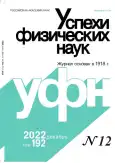A solemn meeting (scientific session) of the Physical Sciences Division (PSD) and the Nanotechnology Division of the Russian Academy of Sciences (RAS), as well as the Scientific Councils of the P N Lebedev Physical Institute (LPI) RAS and the A M Prokhorov General Physics Institute (GPI) RAS, On the 100th Anniversary of the Birth of N G Basov: the ‘BASOV READINGS,’ was held in the Assembly Hall of the P N Lebedev Physical Institute on November 28, 2022.Opening remarks were made by:Kolachevsky N N (LPI), Kveder V V (PSD RAS), Garnov S V (GPI RAS).The scientific program of the joint meeting, published on the website of the PSD RAS (http://www.gpad.ac.ru), included the following reports and speeches:Session 1. Chair: Academician G A Mesyats1. Zubarev I G (LPI, National Research Nuclear University (NRNU) Moscow Engineering Physics Institute (MEPhI), Moscow). N G Basov: a pioneer and organizer of laser research in the USSR.2. Kolachevsky N N (LPI, Moscow). From the first masers to optical frequency standards.3. Pikhtin N A (A F Ioffe Physico-Technical Institute (PTI) RAS, St. Petersburg). {High-power near-IR laser diodes: history, state of the art, and development prospects.}4. Konov V I (Natural Science Research Center, GPI RAS, Moscow). {Modern micro- and nanotechnologies of laser material processing.}Session 2. Chair: Academician I A Shcherbakov5. Gus'kov S Yu (LPI, Moscow). N G Basov: laser thermonuclear fusion and high energy density physics.6. Mikaelyan G T (LASSARD LLC, NPP Inzhekt LLC, Moscow). One- and two-D diode laser arrays. Technology of production and application.7. Starodubtsev M V (FRC Institute of Applied Physics RAS, Nizhny Novgorod). Research in the field of plasma physics and particle acceleration on the PEARL petawatt laser.8. Evtikhiev N N (STA IRE Polyus, NRNU MEPhI, Moscow). On the application of laser technologies in industry and medicine.9. El'tsov K N (GPI RAS). Surface physics for heterogeneous catalysis, quantum computing, and two-dimensional materials.10. Zvorykin V D (LPI, Moscow). \textit{The role of N G Basov in work on excimer laser research: a half-century history from the launch of the first $ Xe_{2}$ laser at the LPI to modern laser systems.}Articles written on the basis of the presented reports will be published in a special issue of the journal Physics–Uspekhi (Uspekhi Fizicheskikh Nauk (UFN)).At the meeting, a fragment from the film “Prometheus of the Laser Era” (author of the film: L E Ioffe), prepared for the N G Basov anniversary, as well as the presentation of the books N G Basov i Issledovaniya po Kvantovoi Radiofizike v FIAN (N G Basov and Research on Quantum Radiophysics at LPI) and the photo album Nikolai Gennadievich Basov. K 100-letiyu so Dnya Rozhdeniya (Nikolai Gennadievich Basov. On the 100th Anniversary of His Birth). For more details on the books, see Phys. Usp.65 (12) 1321–1322 (2022) (Usp. Fiz. Nauk 191 1415 (2022).
 1297-1298
1297-1298


 1299-1299
1299-1299


 1300-1304
1300-1304


 1305-1312
1305-1312


 1313-1338
1313-1338


 1339-1384
1339-1384


 1385-1398
1385-1398


 1399-1408
1399-1408


 1409-1412
1409-1412


 1413-1414
1413-1414


 1415-1415
1415-1415


 1416-1416
1416-1416









